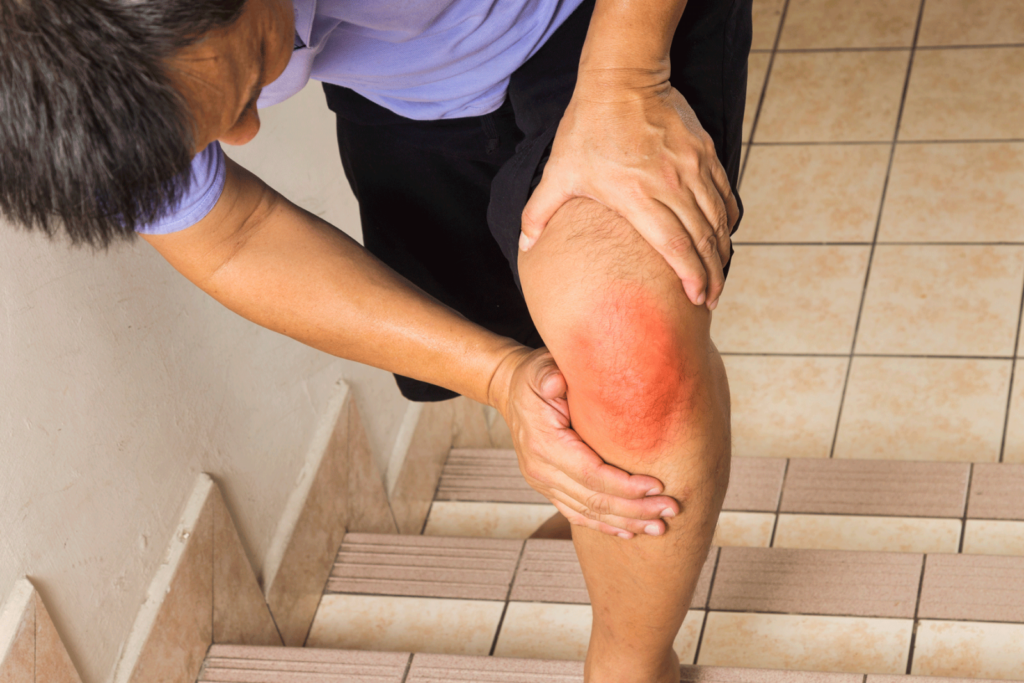Related (Ads):
Arthritis is no fun. Everyone who has it will tell you that. But it does not mean that life is over. There’s a variety of things you can do to get ahead, if you think you might have Arthritis or Psoriatic Arthritis.
Psoriatic arthritis is a type of inflammatory arthritis that affects some people who have psoriasis, a chronic skin condition characterized by red, raised patches of skin covered with silvery-white scales. Psoriatic arthritis typically develops in individuals with psoriasis, but it can occur without the skin condition as well.
The exact cause of psoriatic arthritis is not fully understood, but it is believed to involve a combination of genetic, immune system, and environmental factors. The immune system mistakenly attacks healthy tissues, leading to inflammation in the joints and skin.

Symptoms of psoriatic arthritis & the effects is can have can vary widely. But they may include:
- Joint pain and stiffness: Psoriatic arthritis commonly affects the joints, causing pain, swelling, and stiffness. The joints most commonly involved are those of the fingers and toes, but it can affect any joint, including the spine.
- Psoriasis symptoms: Skin symptoms may include red, scaly patches of skin, which are characteristic of psoriasis. These symptoms may precede, coincide with, or follow joint symptoms.
- Swelling and tenderness: Joints affected by psoriatic arthritis may become swollen and tender to the touch.
- Nail changes: Psoriatic arthritis can cause changes to the nails, such as pitting (small dents or depressions), ridges, or discoloration.
- Fatigue: Many people with psoriatic arthritis experience fatigue, which may be related to the inflammation and the body’s efforts to cope with it.
- Difficulty with Grip and Dexterity: Affected joints, particularly in the hands and fingers, may lead to difficulties with gripping objects, typing, or performing fine motor tasks.
- Swelling and Tenderness: Swollen and tender joints may be sensitive to pressure, making activities that involve those joints more uncomfortable.
- Skin Symptoms: For individuals with both psoriasis and psoriatic arthritis, skin symptoms like red, scaly patches can be a visible and potentially distressing aspect of the condition.
- Impact on Work: Depending on the nature of one’s occupation, psoriatic arthritis can affect job performance, especially if it involves physical tasks or requires prolonged periods of sitting or standing.
- Impact on Personal Care: Daily activities such as bathing, dressing, and grooming may become more challenging due to joint pain and stiffness.
- Emotional Impact: Living with a chronic condition can take a toll on a person’s mental and emotional well-being. Dealing with pain, fatigue, and the impact on daily life can lead to stress, anxiety, or depression.
- Sleep Disturbances: Pain and discomfort may interfere with sleep, contributing to fatigue and exacerbating the overall impact on daily activities.
It’s important for individuals experiencing symptoms suggestive of psoriatic arthritis to seek medical attention. Early diagnosis and treatment can help manage symptoms, prevent joint damage, and improve the overall quality of life for people with this condition. Treatment may include medications to reduce inflammation, physical therapy, and lifestyle modifications. A rheumatologist, a doctor specializing in arthritis and related conditions, typically manages the care of individuals with psoriatic arthritis.
On the other hand, Arthritis is a broad term that refers to inflammation of the joints. There are many different types of arthritis, and psoriatic arthritis is just one specific form. The main difference between psoriatic arthritis and other forms of arthritis, such as osteoarthritis or rheumatoid arthritis, lies in its association with the skin condition psoriasis.

Here are some key distinctions:
- Psoriatic Arthritis and Psoriasis:
- Association with Psoriasis: Psoriatic arthritis is associated with psoriasis, a chronic skin condition characterized by red, scaly patches. Not everyone with psoriasis develops psoriatic arthritis, but the two conditions often coexist.
- Skin Involvement: Psoriatic arthritis involves both joint inflammation and skin symptoms, distinguishing it from other types of arthritis.
- Rheumatoid Arthritis:
- Autoimmune Nature: Rheumatoid arthritis is an autoimmune disease where the immune system mistakenly attacks the synovium (the lining of the membranes that surround the joints). Psoriatic arthritis also has autoimmune components, but the specific mechanisms differ.
- Osteoarthritis:
- Degenerative vs. Inflammatory: Osteoarthritis is primarily a degenerative joint disease resulting from wear and tear on the joints over time. Psoriatic arthritis, on the other hand, is an inflammatory arthritis where the immune system attacks the joints.
- Ankylosing Spondylitis:
- Spine Involvement: Ankylosing spondylitis is another form of inflammatory arthritis that primarily affects the spine. While psoriatic arthritis can also affect the spine, ankylosing spondylitis tends to cause more significant inflammation in the spinal joints.
Psoriatic arthritis is a specific type of inflammatory arthritis associated with the skin condition psoriasis. Its distinct features involve joint inflammation, skin symptoms, and potential nail changes. Other forms of arthritis have different causes, manifestations, and patterns of joint involvement. If someone is experiencing joint pain or related symptoms, consulting with a healthcare professional for an accurate diagnosis is crucial for appropriate management and treatment.

Is having Psoriatic Arthritis worse than having ordinary Arthritis?
The severity and impact of psoriatic arthritis compared to other forms of arthritis, often referred to as “ordinary arthritis,” can vary widely from person to person. It’s important to note that “ordinary arthritis” is a bit of a broad term that could encompass various types, including osteoarthritis or other autoimmune forms like rheumatoid arthritis. Each type of arthritis has its own characteristics, causes, and potential impact on an individual’s life.
Here are some considerations regarding psoriatic arthritis:
- Varied Severity: Psoriatic arthritis can range from mild to severe. In some cases, individuals may experience relatively mild joint pain and stiffness, while others may face more significant inflammation and joint damage.
- Joint and Skin Involvement: One distinctive aspect of psoriatic arthritis is its association with psoriasis, a chronic skin condition. This dual impact on both joints and skin can influence the overall experience of the disease.
- Effects on Quality of Life: Psoriatic arthritis, like other forms of arthritis, can affect a person’s quality of life. Pain, stiffness, fatigue, and potential joint damage can impact daily activities, work, and overall well-being.
- Individual Variability: Each person’s experience with arthritis is unique. Factors such as the specific joints affected, the presence and severity of skin symptoms, overall health, and how well the condition responds to treatment can vary.
- Treatment Options: Advances in treatment options have improved the management of psoriatic arthritis. Medications, lifestyle changes, and other interventions can help control symptoms and prevent joint damage. Early diagnosis and appropriate treatment are crucial for better outcomes.
Comparing the “worseness” of psoriatic arthritis to “ordinary arthritis” may not be straightforward, as it depends on the specific type of arthritis being considered, the individual’s symptoms, and how well the condition responds to treatment. It’s essential for individuals with arthritis to work closely with healthcare professionals to develop a personalized treatment plan tailored to their needs and circumstances. Regular monitoring and adjustments to the treatment plan may be necessary to manage symptoms effectively and improve overall quality of life.

What are the best treatment options for someone who has Psoriatic Arthritis?
The treatment of psoriatic arthritis aims to manage symptoms, control inflammation, and prevent joint damage. The most appropriate treatment plan varies from person to person, and it often involves a combination of medications, lifestyle modifications, and sometimes surgery. Here are some common treatment options for psoriatic arthritis:
- Nonsteroidal Anti-Inflammatory Drugs (NSAIDs): These medications, such as ibuprofen or naproxen, can help reduce pain and inflammation. They are often used for mild to moderate symptoms.
- Disease-Modifying Antirheumatic Drugs (DMARDs):
- Conventional DMARDs: Drugs like methotrexate may be prescribed to slow the progression of joint damage and reduce symptoms.
- Biologic DMARDs: These drugs, such as tumor necrosis factor (TNF) inhibitors (e.g., etanercept, adalimumab), interleukin inhibitors (e.g., secukinumab, ixekizumab), and other biologics, target specific pathways in the immune system to control inflammation. Biologics are often used for moderate to severe psoriatic arthritis.
- Corticosteroids: These may be injected directly into affected joints to reduce inflammation and provide relief. Oral or topical corticosteroids may also be used for short-term symptom management.
- Physical Therapy: Exercises and physical therapy can help improve joint function, reduce pain, and increase flexibility. A physical therapist can design a program tailored to an individual’s needs.
- Lifestyle Modifications:
- Joint Protection: Implementing joint protection techniques can help manage symptoms. This may include using assistive devices, avoiding excessive strain on joints, and maintaining a healthy weight.
- Exercise: Regular, low-impact exercise, such as swimming or walking, can help maintain joint function and reduce stiffness.
- Stress Management: Stress can exacerbate symptoms, so stress management techniques may be beneficial.
- Surgery: In severe cases, joint replacement surgery may be considered, particularly if joints are significantly damaged and impacting daily life.
It’s important for individuals with psoriatic arthritis to work closely with a rheumatologist or another healthcare professional to develop a personalized treatment plan. Regular monitoring and adjustments may be necessary to ensure the most effective management of symptoms. Early diagnosis and treatment can help prevent joint damage and improve long-term outcomes. Additionally, ongoing communication with healthcare providers is crucial to address any concerns, side effects, or changes in symptoms.
Related (Ads):

What are the best prescription medications for psoriatic arthritis?
The choice of prescription medications for psoriatic arthritis depends on the severity of symptoms, the extent of joint involvement, the presence of skin manifestations, and individual factors such as overall health and preferences. Here are some categories of prescription medications commonly used to treat psoriatic arthritis:
- Nonsteroidal Anti-Inflammatory Drugs (NSAIDs):
- Examples: Ibuprofen, naproxen, celecoxib.
- Function: NSAIDs can help reduce pain and inflammation. They are often used for mild to moderate symptoms.
- Disease-Modifying Antirheumatic Drugs (DMARDs):
- Conventional DMARDs:
- Methotrexate: This is a common first-line treatment. It can slow disease progression and reduce symptoms.
- Sulfasalazine: Another conventional DMARD that may be used, particularly if methotrexate is not well-tolerated.
- Biologic DMARDs:
- Tumor Necrosis Factor (TNF) Inhibitors: Examples include etanercept, adalimumab, and infliximab. These drugs target TNF, a protein involved in the inflammatory process.
- Interleukin Inhibitors: Examples include secukinumab, ixekizumab, and ustekinumab. They target different pathways in the immune system to control inflammation.
- Janus Kinase (JAK) Inhibitors: Examples include tofacitinib and upadacitinib. These drugs interfere with specific enzymes involved in the immune response.
- Phosphodiesterase-4 (PDE-4) Inhibitor: Apremilast is an oral medication that modulates the immune response.
- Conventional DMARDs:
- Corticosteroids:
- Oral or Injectable: Short-term use of oral corticosteroids or injections into affected joints can provide rapid relief of symptoms.
- Topical: Creams or ointments containing corticosteroids may be used for skin symptoms.
- Immunosuppressive Drugs:
- Cyclosporine: In some cases, this immunosuppressive medication may be used to control symptoms, particularly when other medications are not effective.
- Targeted Synthetic DMARDs:
- Phosphodiesterase-4 (PDE-4) Inhibitor: Apremilast is a targeted synthetic DMARD that modulates the immune response.
The choice of medication is often individualized, and treatment plans may involve a combination of drugs. Factors such as the severity of the disease, the presence of skin involvement, comorbidities, and patient preferences are considered when selecting medications.
It’s important for individuals with psoriatic arthritis to work closely with their healthcare team, particularly a rheumatologist, to determine the most appropriate treatment plan. Regular monitoring, communication about symptoms, and adjustments to the treatment plan may be necessary to optimize outcomes.

What are some of the most popular & effective medications for Psoriatic Arthritis?
Several name-brand prescription medications have been approved for the treatment of psoriatic arthritis. It’s important to note that the choice of medication depends on individual factors, and what works best for one person may not be the same for another. Additionally, new medications may be developed, and treatment approaches can evolve. Here are some commonly used name-brand medications for psoriatic arthritis:
- Tumor Necrosis Factor (TNF) Inhibitors:
- Enbrel (etanercept): This is a TNF inhibitor that can be effective in reducing joint inflammation.
- Humira (adalimumab): Adalimumab is another TNF inhibitor used to treat psoriatic arthritis.
- Remicade (infliximab): Administered by infusion, infliximab is another TNF inhibitor.
- Interleukin Inhibitors:
- Cosentyx (secukinumab): Secukinumab targets interleukin-17A and is used to treat both psoriatic arthritis and plaque psoriasis.
- Taltz (ixekizumab): Ixekizumab is another interleukin-17A inhibitor indicated for psoriatic arthritis.
- Stelara (ustekinumab): Ustekinumab targets interleukin-12 and interleukin-23 and is approved for psoriatic arthritis.
- Janus Kinase (JAK) Inhibitors:
- Xeljanz (tofacitinib): Tofacitinib is a JAK inhibitor used for the treatment of psoriatic arthritis.
- Phosphodiesterase-4 (PDE-4) Inhibitor:
- Otezla (apremilast): Apremilast is an oral medication that inhibits PDE-4 and is used for the treatment of psoriatic arthritis.
It’s essential to consult with a rheumatologist or another healthcare professional to determine the most appropriate medication based on the individual’s specific condition, medical history, and preferences. Treatment plans may involve a combination of medications, and regular follow-ups are typically required to monitor the effectiveness of the chosen therapy and make adjustments as needed. Additionally, new medications may have been approved since my last update, so it’s advisable to check with a healthcare provider for the latest information.

The Goal is Pain Relief & Pain Management, Not Necessarily A Cure
There is no cure for psoriatic arthritis. Medications used in the treatment of psoriatic arthritis, including nonsteroidal anti-inflammatory drugs (NSAIDs), disease-modifying antirheumatic drugs (DMARDs), biologics, and others, are aimed at relieving symptoms, reducing inflammation, and preventing joint damage. These treatments can be highly effective in managing the condition and improving the quality of life for individuals with psoriatic arthritis, but they do not eliminate the underlying cause of the disease.
The goals of treatment include:
- Symptom Relief: Medications such as NSAIDs provide relief from symptoms like pain and swelling.
- Inflammation Control: DMARDs and biologics work to modulate the immune system and reduce inflammation, helping to prevent further joint damage.
- Improved Function: Physical therapy and lifestyle modifications may be incorporated into the treatment plan to enhance joint function and mobility.
- Management of Psoriasis: For individuals with both psoriasis and psoriatic arthritis, certain medications can help manage skin symptoms.
While these treatments can significantly improve the quality of life for individuals with psoriatic arthritis, the condition is chronic, and ongoing management is typically necessary. Regular follow-ups with healthcare providers are important to monitor the effectiveness of treatment, address any changes in symptoms, and make adjustments to the treatment plan as needed.
Research is ongoing in the field of rheumatology, and new developments may occur over time. However, as of now, the focus is on managing symptoms and preventing complications rather than providing a definitive cure. Always consult with healthcare professionals for the latest information on treatment options and advances in the field.
Pain relief for psoriatic arthritis can be achieved through various types of medication. The choice of medication depends on the severity of symptoms, individual response to treatment, and the specific characteristics of the condition. Here are some types of medications commonly used for pain relief in psoriatic arthritis:
- Nonsteroidal Anti-Inflammatory Drugs (NSAIDs):
- Examples: Ibuprofen, naproxen, celecoxib.
- Function: NSAIDs help reduce pain and inflammation by inhibiting certain enzymes involved in the inflammatory process. They are often used for mild to moderate pain relief.
- Analgesics:
- Examples: Acetaminophen.
- Function: Analgesics such as acetaminophen can provide pain relief without having the anti-inflammatory properties of NSAIDs. They are commonly used for mild pain.
- Disease-Modifying Antirheumatic Drugs (DMARDs):
- Examples: Methotrexate, sulfasalazine.
- Function: While DMARDs are primarily used to slow the progression of psoriatic arthritis and prevent joint damage, they can also contribute to reducing pain and inflammation.
- Biologic DMARDs:
- Examples: Etanercept, adalimumab, infliximab, secukinumab, ixekizumab, ustekinumab, and others.
- Function: Biologics target specific pathways in the immune system to control inflammation and can provide significant pain relief. They are often used for moderate to severe psoriatic arthritis.
- Corticosteroids:
- Examples: Prednisone, cortisone injections.
- Function: Corticosteroids have potent anti-inflammatory effects and can provide rapid relief of pain and swelling. They are often used for short-term symptom management.
- Janus Kinase (JAK) Inhibitors:
- Examples: Tofacitinib, upadacitinib.
- Function: JAK inhibitors interfere with specific enzymes involved in the immune response, helping to control inflammation and reduce pain.
- Topical Medications:
- Examples: Topical NSAIDs, capsaicin cream.
- Function: Topical medications applied directly to the skin over affected joints can provide localized pain relief.
It’s important to note that the effectiveness of pain relief may vary among individuals, and healthcare professionals may recommend a combination of medications to address specific symptoms. Additionally, non-pharmacological approaches, such as physical therapy, exercise, and lifestyle modifications, can complement medication management in providing pain relief and improving overall function in individuals with psoriatic arthritis. Always consult with a healthcare provider to determine the most appropriate and effective treatment plan for your specific situation.

Which Joints and what areas of the body does Psoriatic Arthritis usually affect?
Psoriatic arthritis (PsA) can affect various joints throughout the body. The pattern of joint involvement in psoriatic arthritis is diverse, and symptoms can vary widely among individuals. The most commonly affected joints include:
- Peripheral Joints:
- Small Joints of the Hands and Feet: Psoriatic arthritis often involves the joints closest to the fingertips and toes, leading to symptoms such as swelling, pain, and stiffness. Dactylitis, which is swelling of an entire finger or toe, is a characteristic feature.
- Wrists, Knees, and Ankles: Larger joints like the wrists, knees, and ankles may also be affected, resulting in pain and inflammation.
- Axial Skeleton:
- Spine: Psoriatic arthritis can affect the spine, leading to inflammation in the sacroiliac joints (sacroiliitis) and the spine itself (spondylitis). This involvement may cause lower back pain, stiffness, and difficulty with spinal mobility.
- Entheses:
- Entheses are the areas where tendons or ligaments attach to bones. Psoriatic arthritis commonly affects entheses, resulting in a condition known as enthesitis. Common sites for enthesitis include the heel (Achilles tendonitis), the bottoms of the feet, and the elbows.
- Distal Interphalangeal (DIP) Joints:
- The DIP joints are the joints at the tips of the fingers and toes. Psoriatic arthritis may cause inflammation and deformities in these joints.
- Nails:
- Psoriatic arthritis can also affect the nails, leading to changes such as pitting, ridges, and separation from the nail bed.
It’s important to note that the course of psoriatic arthritis can vary among individuals. Some people may experience mild symptoms affecting only a few joints, while others may have more widespread and severe joint involvement. The disease can progress over time, and early diagnosis and treatment are crucial to managing symptoms and preventing joint damage.
If someone is experiencing symptoms suggestive of psoriatic arthritis, such as joint pain, swelling, or skin changes, they should seek medical attention. A healthcare professional, typically a rheumatologist, can conduct a thorough evaluation, including a physical examination, imaging studies, and laboratory tests, to diagnose psoriatic arthritis and develop an appropriate treatment plan.

At What Age Do People Normally Start Getting Psoriatic Arthritis?
Psoriatic arthritis can develop at any age, but it most commonly appears in adults between the ages of 30 and 50. However, it is important to note that psoriatic arthritis can occur in individuals both younger and older than this typical age range.
Psoriatic arthritis is associated with psoriasis, a chronic skin condition characterized by red, scaly patches of skin. Psoriasis usually develops first, and psoriatic arthritis may follow. In some cases, joint symptoms may precede the skin symptoms, or individuals may develop both conditions simultaneously.
Psoriatic arthritis can also affect children, although this is less common than in adults. When it occurs in children, it is referred to as juvenile psoriatic arthritis.
It’s important to recognize the early signs and symptoms of psoriatic arthritis, such as joint pain, swelling, and stiffness, especially in individuals with psoriasis or a family history of psoriatic arthritis. Early diagnosis and intervention can help manage symptoms, prevent joint damage, and improve long-term outcomes.
If someone is experiencing symptoms suggestive of psoriatic arthritis, they should seek medical attention. A healthcare professional, typically a rheumatologist, can conduct a thorough evaluation, which may include a physical examination, imaging studies, and laboratory tests, to diagnose and determine the most appropriate treatment plan.
Related (Ads):